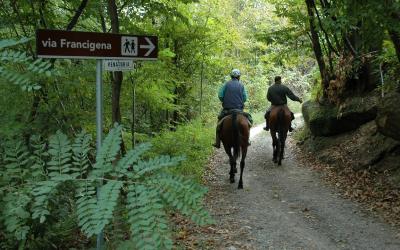Stretching over 15,000 hectares between the two consular roads, Flaminia and Cassia, north of Rome, the Veio Park is a green lung full of historical, cultural and natural wonders.
The Park area is extremely diverse and its appearance, modelled over the centuries by nature and human activities, preserves the traces of different historical phases. The heart of the Etruscan territory, conquered by the Romans, it was transformed during the Middle Ages into a rural area, still evidenced by the farmhouses of the vast estates dotting the landscape. The park offers an extensive network of footpaths and cycle paths (99 km), and visitors are free to choose those that best suit their abilities and needs. Hiking trails cross wide plains, cultivated or dedicated to cattle and horse farming, alternated with mixed forests animated by gorges and dizzy hollows carved out by the river. The park is also surrounded by other green areas - the Insugherata Nature Reserve, the Bracciano-Martignano Nature Park and the Valle del Treja Nature Park - which together create a belt for the protection of biodiversity. The park does in fact contain a true environmental heritage: 145 species of animals and more than 700 varieties of flora have been recorded. Curiosities Many of these agricultural or grazing lands have also been preserved thanks to the “civic uses”, a rule of ancient common law which assigns to local communities the collective management of natural resources and the custody of landscapes.
NOT TO BE MISSED
Ideal for hiking or horse riding enthusiasts, this green valley, inside the Veio Park, offers truly enchanting scenery.
Characterised by tufa gullies excavated by the Cremera River, the area has been included among the Sites of Community Importance (SCI) and designated a Special Area of Conservation (SAC) for its special natural and environmental importance.
On the ruins of Sorbo Castle, some remains of which can still be seen near the square in front of the church, after a legendary apparition, the Orsini family, then owners of the fiefdom of Formello, financed the construction of a shrine dedicated to the Madonna. The date of completion – 1487 – is still clearly visible on the entrance to the church.
The architectural complex is surrounded by nature and the elegant Renaissance structures are still well preserved. Numerous frescoes can be admired in the church as well as in some of the rooms of the convent.
Near the village of Isola Farnese are the remains of Veio, an important centre of the Etruscan civilisation. Among the main monuments is the Sanctuary of Portonaccio, dedicated to Minerva, surrounded by walls with an altar in the centre and a water basin used for ritual purposes.
All around are several tombs, including the Tomb of the Roaring Lions and the Tomb of the Ducks, which preserve some of the oldest Etruscans wall paintings.












